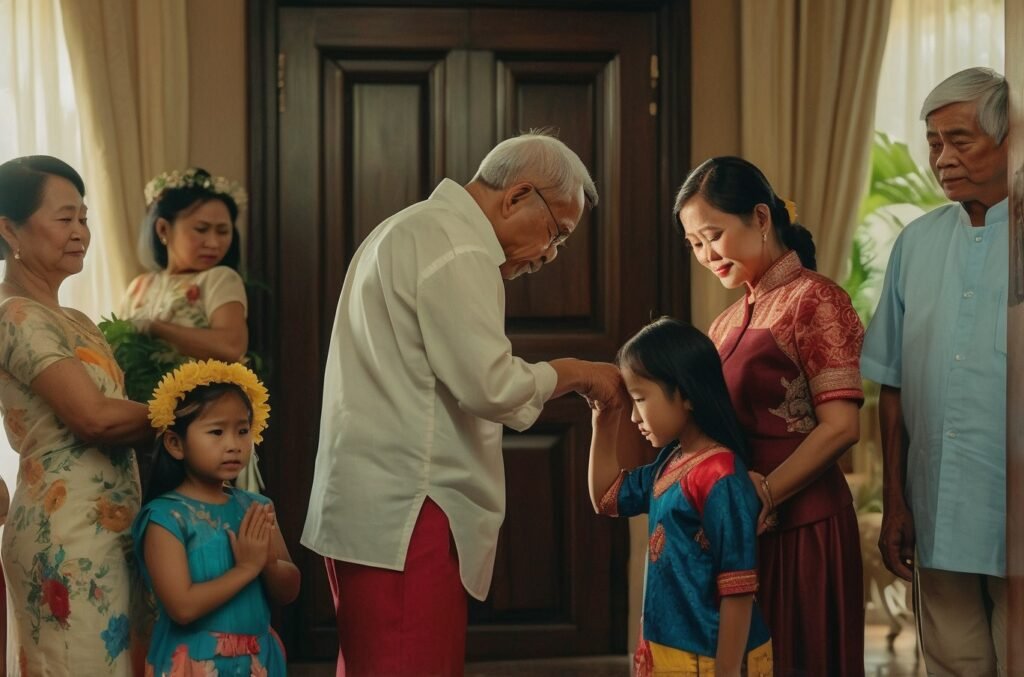Harana, a time-honored Filipino courtship tradition, has played a significant role in shaping the romantic landscape of the Philippines for centuries. This enchanting practice, deeply rooted in Filipino culture, involves a man serenading a woman with heartfelt songs, typically accompanied by a guitar, beneath her window or balcony. The custom of harana, which literally translates to “serenade” in English, is not merely a musical performance but a complex social ritual that embodies the values, etiquette, and artistic expression of Filipino society. As we delve into the rich tapestry of harana, we will explore its historical origins, cultural significance, and the various elements that make this tradition a unique and cherished aspect of Filipino heritage. From the intricate melodies to the poetic lyrics, harana represents a beautiful fusion of music, romance, and social customs that continue to captivate both Filipinos and international audiences alike.
Historical Origins of Harana
Pre-Colonial Roots
The origins of harana can be traced back to pre-colonial Philippines, where various forms of courtship rituals existed among different ethnic groups. These indigenous practices often involved music and poetry as means of expressing romantic interest. However, the specific form of harana as we know it today began to take shape during the Spanish colonial period, which lasted from the 16th to the 19th century.
Spanish Influence
The arrival of Spanish colonizers in the Philippines in 1565 brought significant changes to the cultural landscape of the archipelago. Among these influences was the introduction of Western musical instruments, particularly the guitar, which would become an integral part of harana. The Spanish tradition of serenading, known as “serenata,” also had a profound impact on the development of harana. This cultural exchange resulted in a unique blend of indigenous Filipino courtship practices and Spanish musical traditions.
Evolution in the 19th and 20th Centuries
As harana evolved throughout the 19th and early 20th centuries, it became more structured and refined. The practice gained popularity among the rural and urban populations alike, with regional variations emerging across different parts of the Philippines. During this period, harana became an essential element of Filipino courtship, serving as a socially acceptable way for young men to express their romantic intentions and for women to assess potential suitors.
The Cultural Significance of Harana
Expression of Filipino Values
Harana is more than just a musical performance; it embodies several core Filipino values and social norms. The practice reflects the importance of respect, propriety, and family involvement in courtship. By adhering to the structured rituals of harana, suitors demonstrate their sincerity, patience, and willingness to follow social conventions. This adherence to tradition is highly valued in Filipino culture and serves as a testament to the suitor’s character.
Preservation of Oral Traditions
Harana plays a crucial role in preserving Filipino oral traditions and musical heritage. The songs used in harana often contain elements of traditional Filipino poetry, such as the “tanaga” and “diona,” which are characterized by their use of metaphors and symbolism. Through the practice of harana, these poetic forms and musical styles are passed down from generation to generation, ensuring their continued existence in modern Filipino culture.
Community Bonding
The performance of harana often involves not just the suitor and his intended but also friends, family members, and even neighbors. This communal aspect of harana strengthens social bonds within the community and provides an opportunity for shared cultural experiences. The gathering of spectators and supporters during a harana performance creates a festive atmosphere that celebrates love, music, and tradition.
The Process and Etiquette of Harana
Preparation and Planning
A successful harana requires careful preparation and planning. The suitor must select appropriate songs, practice his musical skills, and gather a group of friends or musicians to accompany him. The timing of the harana is also crucial, typically taking place in the evening or early night when the household is settling down.
Arrival and Introduction
Upon arriving at the woman’s house, the haranista (the man performing the harana) and his companions would announce their presence, often by calling out “Mayroon po!” (Somebody’s here!). This polite announcement serves to alert the household of their arrival and request permission to perform the serenade.
The Performance
If granted permission, the haranista begins his serenade, usually starting with songs that express his admiration and romantic intentions. The performance typically consists of several songs, carefully chosen to convey the suitor’s feelings and showcase his musical abilities. The woman being serenaded may listen from inside the house or, if interested, may come to the window or balcony to hear the performance.
Interaction and Response
The response of the woman and her family plays a crucial role in the harana. If the serenade is well-received, the woman may request additional songs or invite the haranista and his companions inside for refreshments. However, if the family disapproves or the woman is not interested, they may politely decline further performances or simply not respond.
Conclusion of the Harana
The harana concludes with the haranista expressing gratitude for the opportunity to perform, regardless of the outcome. If invited inside, the suitor may have a chance for more direct interaction with the woman and her family, but always within the bounds of propriety and under supervision.
Musical Elements of Harana
Instruments
The primary instrument used in harana is the guitar, which was introduced to the Philippines during the Spanish colonial period. The guitar’s portability and ability to provide both melody and harmony make it ideal for serenading. In some cases, other string instruments like the bandurria or ukulele may also be used to accompany the guitar.
Song Types and Styles
Harana songs can be categorized into several types, each serving a different purpose within the serenade:
- Panawagan (Calling Songs): These are used to announce the haranista’s presence and request permission to perform.
- Pagtatapat (Declaration Songs): These express the suitor’s feelings and intentions towards the woman.
- Pagtangi (Rejection Songs): If the serenade is not well-received, these songs allow the haranista to gracefully accept rejection.
- Pagpapaalam (Farewell Songs): These conclude the harana, expressing gratitude and bidding farewell.
Lyrical Themes
The lyrics of harana songs often incorporate romantic themes, natural imagery, and poetic devices. Common subjects include:
- Declarations of love and admiration
- Comparisons of the beloved to natural beauty (e.g., flowers, stars)
- Expressions of longing and devotion
- Requests for the beloved’s affection or attention
Regional Variations of Harana
While harana is practiced throughout the Philippines, regional variations exist, reflecting the diverse cultural landscape of the archipelago. Here are some notable regional styles:
| Region | Harana Style | Characteristics |
|---|---|---|
| Tagalog | Traditional Harana | Emphasis on poetic lyrics and guitar accompaniment |
| Ilocano | Tapat | Incorporates local musical styles and instruments |
| Cebuano | Balak | Features more elaborate vocal performances and harmonies |
| Bicolano | Tigsik | Includes elements of local folk poetry and melodies |
These regional variations add to the rich tapestry of harana traditions across the Philippines, each contributing unique elements to the overall practice.
Harana in Modern Filipino Culture
Decline and Revival
The practice of harana began to decline in the mid-20th century due to various factors, including urbanization, changing social norms, and the influence of Western popular culture. However, in recent years, there has been a renewed interest in harana as part of a broader movement to preserve and celebrate Filipino cultural heritage.
Contemporary Adaptations
Modern interpretations of harana have emerged, adapting the tradition to contemporary contexts:
- Harana in Popular Music: Filipino musicians have incorporated elements of harana into modern pop and rock songs, keeping the spirit of the tradition alive in new musical forms.
- Cultural Events and Festivals: Harana performances are often featured in cultural festivals and events, showcasing the tradition to new generations and international audiences.
- Educational Programs: Some schools and cultural organizations offer workshops and classes on harana, teaching young people about this important aspect of Filipino heritage.
Harana in Media
The tradition of harana has been featured in various forms of media, contributing to its preservation and promotion:
- Films: Movies like “Harana” (2012) have documented the practice and its practitioners, bringing attention to this cultural tradition.
- Television: Filipino TV shows often incorporate harana scenes, familiarizing audiences with the custom.
- Literature: Contemporary Filipino writers continue to reference and explore themes of harana in their works, ensuring its place in modern Filipino literature.
The Global Impact of Harana
Cultural Diplomacy
Harana has become an important element of cultural diplomacy for the Philippines. Performances of harana at international events and cultural exchanges help showcase Filipino musical traditions to global audiences, fostering cross-cultural understanding and appreciation.
Influence on Diaspora Communities
Filipino communities abroad have embraced harana as a way to maintain connections to their cultural roots. Harana performances and workshops in diaspora communities serve to educate younger generations about Filipino traditions and strengthen cultural identity.
Academic Interest
The practice of harana has attracted scholarly attention from ethnomusicologists, anthropologists, and cultural studies researchers. Academic studies on harana contribute to a broader understanding of Filipino culture and its place in global musical traditions.
Preserving Harana for Future Generations
Documentation and Archiving
Efforts are underway to document and archive harana performances, songs, and practices. Organizations like the National Commission for Culture and the Arts (NCCA) in the Philippines are working to create comprehensive records of harana traditions across different regions.
Educational Initiatives
Various educational programs aim to teach harana to younger generations:
- School Curricula: Some schools in the Philippines have incorporated harana into their music and cultural education programs.
- Community Workshops: Local cultural centers and organizations offer workshops on harana, teaching both the musical aspects and the cultural significance of the tradition.
- Online Resources: Digital platforms and social media are being utilized to share information about harana, making it accessible to a wider audience.
Artistic Innovations
Contemporary artists are finding new ways to keep harana relevant in the modern world:
- Fusion Performances: Combining harana with other musical genres to create innovative performances that appeal to younger audiences.
- Interactive Experiences: Developing interactive exhibits and virtual reality experiences that allow people to engage with harana in new and exciting ways.
- Collaborative Projects: Encouraging collaborations between traditional harana performers and contemporary musicians to create bridges between past and present.
Conclusion
Harana stands as a testament to the rich cultural heritage of the Philippines, embodying the romance, musicality, and social values that are integral to Filipino identity. From its historical roots to its modern adaptations, harana continues to captivate and inspire, serving as a unique window into the heart of Filipino culture. As efforts to preserve and promote this tradition continue, harana remains a vibrant and evolving practice, connecting generations and cultures through the universal language of music and love. The enduring appeal of harana lies not only in its beautiful melodies and poetic lyrics but also in its ability to evoke a sense of nostalgia, respect for tradition, and appreciation for the art of courtship. As the Philippines continues to navigate the complexities of the modern world, harana serves as a gentle reminder of the beauty and value of cultural traditions, inspiring both Filipinos and international audiences to cherish and celebrate the diverse tapestry of human expression.
Disclaimer: This article aims to provide accurate information about the tradition of harana based on available historical and cultural sources. However, as with any cultural practice that has evolved over time, some details may vary across different regions and communities. We encourage readers to explore further and engage with local cultural experts for more specific information. If you notice any inaccuracies in this article, please report them so we can promptly make corrections and ensure the most up-to-date and accurate information is presented.




